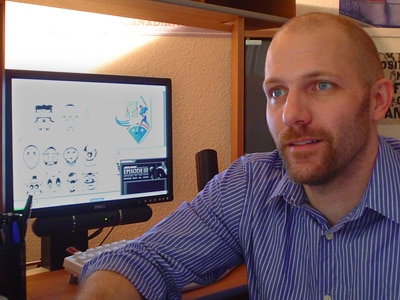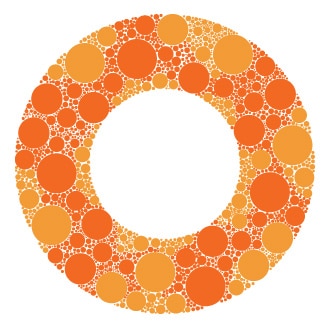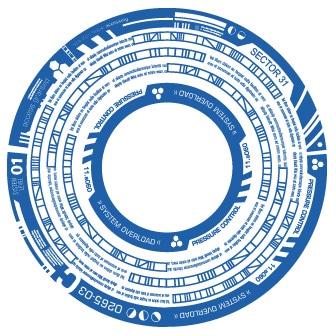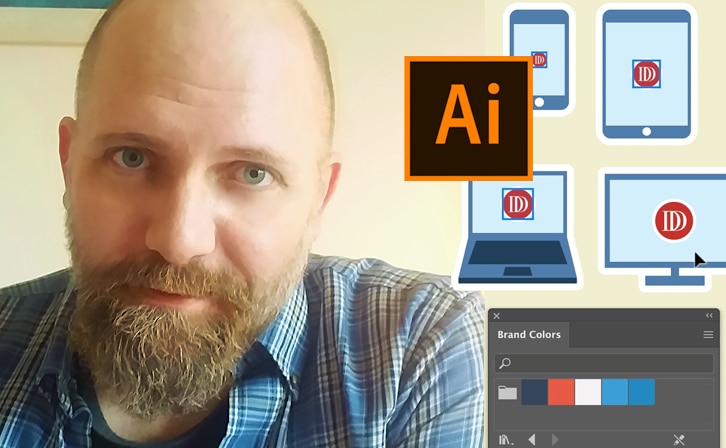Mike Hamm on Adobe Illustrator Innovations

I recently talked with Michael about trends in digital illustration, how to get into the field of digital illustration, and how to best use Adobe Illustrator.
Q: Not that there is any right or wrong way to illustrate, certainly; the computer is just another tool in the art kit. However, what would you suggest to an illustrator drawing by hand, who is making the shift to digital illustration using Adobe Illustrator?
On the one hand, you can make a natural transition to digital illustration with a digital tablet. You see the immediate results on-screen. A challenge for me was training myself to be comfortable looking up at a screen while I drew on the tablet sitting in my lap.
Now, on the other hand, there’s nothing to stop you from continuing to draw by hand. Using a scanner, you can turn your hand-drawn creations into a template that you can then work from in Illustrator. [This method] takes bit more time, but is probably an easier transition to working in Illustrator. I’d say go this route first. See if you’re comfortable with it. If not, then spend your money on the tablet.

One of Mike Hamm’s intricate daily “O”s for The O Project.
Q: Illustrator has been around for over 20 years. What are some creative or new uses for Illustrator, and how has it changed over the years?
The explosion of smart phones in the last several years has given us apps to do amazing things. And each of those apps gets opened through an attention-getting icon that was most likely created in Illustrator. I’ve also seen some beautiful, jaw-dropping 3D images created in high-end 3D software. A surprising number of the shapes and objects in those same images started off in Illustrator and then were exported to the 3D software.
Illustrator may be a seasoned veteran but she always finds ways to remain relevant. It’s continually updated with awesome features and, I feel, reinvented itself with the introduction of mesh painting features back several versions. That moved it from what folks saw as another illustration tool to one that allowed you to create virtually anything in Illustrator. The next challenge for Illustrator is to reinvent itself for use on mobile devices such as the iPad. Having no mouse to use makes things pretty difficult. A mobile capable version of Illustrator—with all the precision and power we’re accustomed to—would be awesome.
Q: How has your personal creative process changed with the evolution of Adobe Illustrator?
As I thought about an answer for this, I came to the realization that it’s the small things—the incremental improvements in tools and features—that have had more of an impact on my process than whiz-bang new features you find in each release. Also, I’ve learned a lot of shortcut keys to speed up my work. Calling up a tool through a shortcut key rather than going over to the toolbar all the time definitely helps.
Q: You mention in your Illustrator course here at Sessions College that you draw much more easily with Illustrator than by hand! What is it about Illustrator that allows you the freedom to make such beautiful art work?
I don’t think I ever allowed myself to hone my “by hand” drawing skills as much as I did my Illustrator drawing skills. Sure I was poor real world drawer, but that didn’t stop me from drawing. Now Illustrator, I found frustrating and it stopped me from drawing. So it became an obstacle to overcome. I’ll tell you, I learned the heck out of Illustrator to the point where I understand—for the most part—how it’s going to behave. Need a curly curly line? I could “real-world” draw it, but the results would be iffy. Give me Illustrator though and you’ll have a super-curly-looking line.

Illustrator art from The O Project showcasing detailed Illustrator gradients and patterns.
Q: How does hardware technology, such as Wacom tablets and smaller and more powerful laptops, change how people use Illustrator?
If we go back to my comment about how Illustrator will need to adapt to a more mobile world to stay relevant: Smaller laptops, tablet computers and, yes, Wacom pads are part of this world. Imagine being able to sketch outdoors with your tablet computer. You’re in the moment. Not to slight using real sketch pads; use that if that’s what you’re comfortable with. But being able to use a powerful illustration program out “in the field” can help you be more creative.
Q: What illustration style trends do you see emerging with the use of Illustrator?
I doubt I could spot a trend emerging for a particular illustration style given the breadth of skills out there. Sites such as Deviant Art, Behance, and so forth bring new work to the surface every day. Maybe it’s a good thing there are not evident trends in this field. I love the variety; it continually amazes and delights me. There’s definitely creative work out there that continually makes me think, “Gosh, I wish I could have done that!”
Q: Who (or what!) is your inspiration as an illustrator? What do you use as your subjects or starting points?
I’m a geek for detail and realism, so I’m drawn toward techy design but also, at the opposite extreme, I love stuff that looks hand-drawn. Being able to make artwork on a computer look hand-made is a big draw for me. It’s funny that you’d ask what subjects I use as starting points, as I’ve just embarked on a project I call “The O Project” where I create a stylized O, in Illustrator, for every day of the year. More details at http://theoproject.tumblr.com. It’s a good example of styles that appeal to me.

A piece from The O Project showcasing Mike’s love of techy design.
Q: Is there a tool that has popped up in recent versions of Illustrator that you simply don’t use?
The Perspective Grid tool. I know there’s a segment of folks out there that do find this really handy but it’s a pretty specialized segment I imagine. Architects could benefit from it but I don’t know that they use Illustrator as frequently as other tools suited to their occupation.
Q: If you could bring any feature into existence for CS6, what would you create or change?
I’ve been using Illustrator a lot more lately as a result of The O Project I mentioned earlier. One of the frustrations I keep encountering concerns gradients. I with there were more gradient types beyond the standard “radial” and “linear.” I’d like to have a more powerful Gradient tool that adapts to a shape. For example, it would be great to control how a gradient moves along a curve. I have workarounds, but a fuller-featured tool would make me happier.
Q: How does an illustrator turn his or her personal talent into a career as you have?
Just get your name and your work out there. Make up stuff. You don’t need a paying project to add to or even create a portfolio. Good stuff gets attention. I’ve gotten so much out of doing my own side projects, not just in self-satisfaction, but in leading to paying work. Above all, keep practicing so you keep your skills fresh.
Thanks, Mike! It’s a great time to be a digital illustrator. Check out more of Mike’s work at Points and Paths and The O Project. Sessions College students can learn more about digital illustration in the Digital Arts Certificate Programs.
Interview by Clara LaFrance, Sessions College Course Producer

Clara LaFrance is a freelance graphic designer when she is not pursuing her dreams as a circus teacher and performer. Clara has an M.F.A. in graphic design from Boston University.





